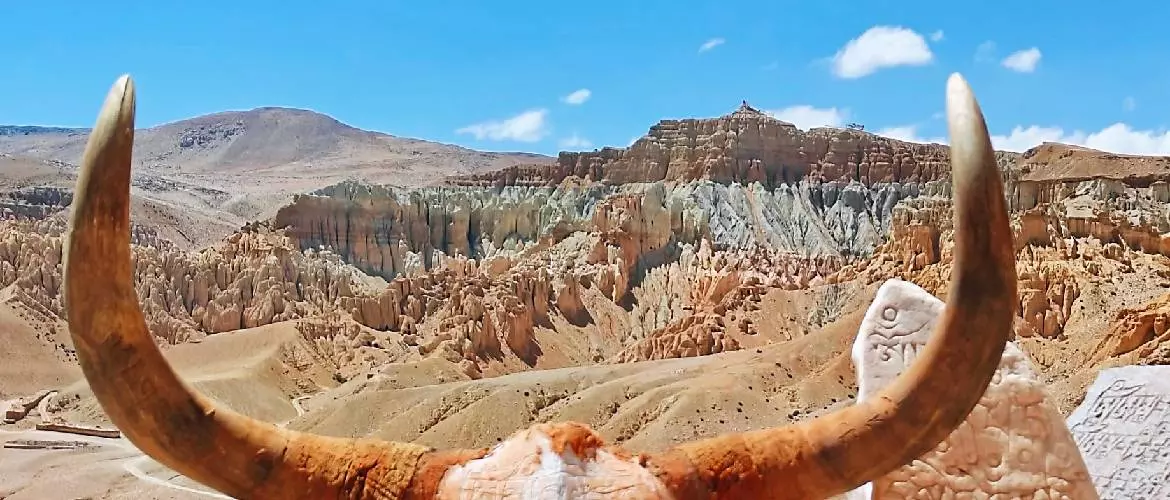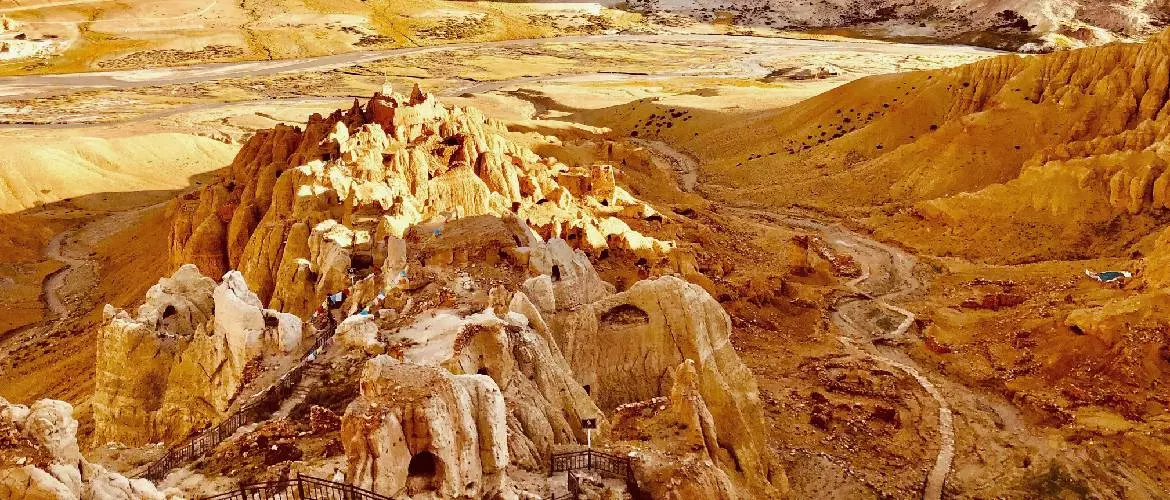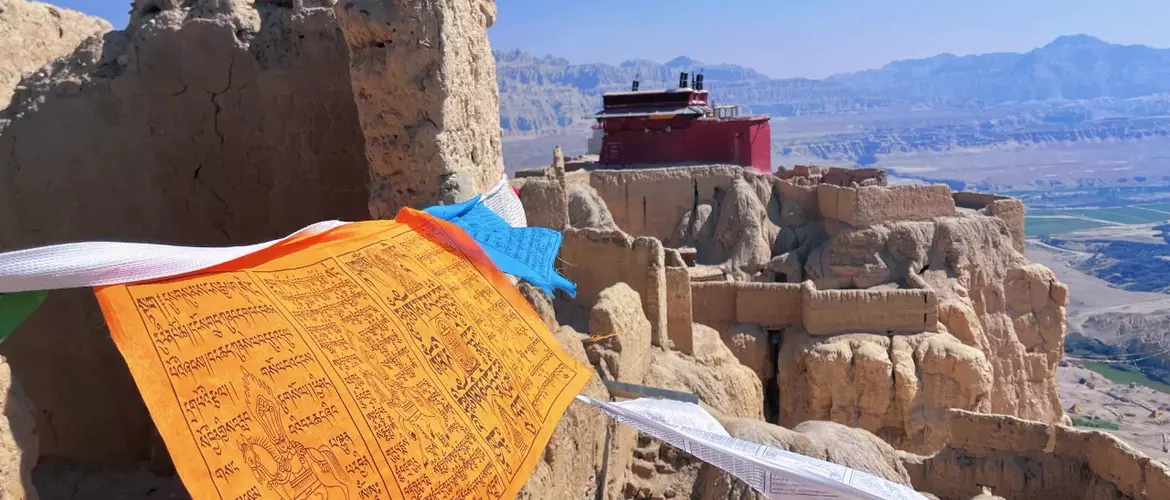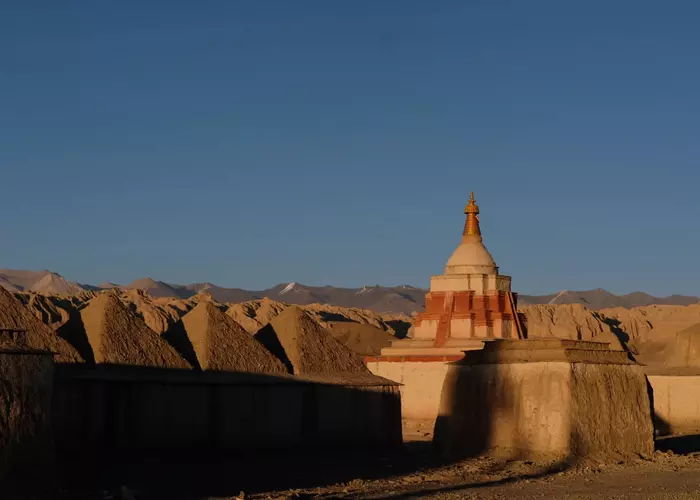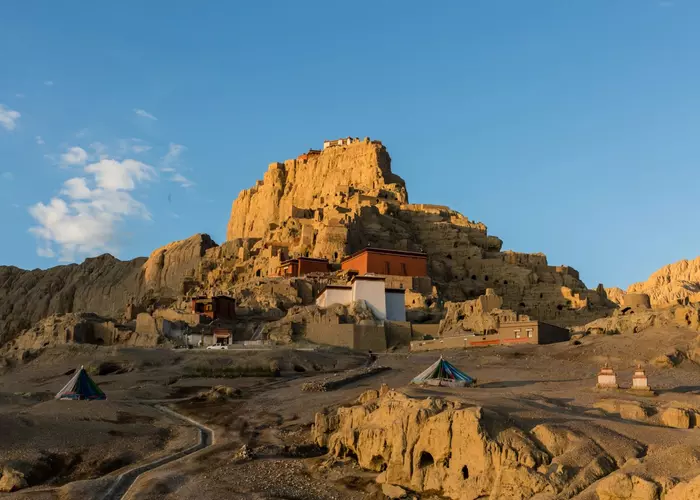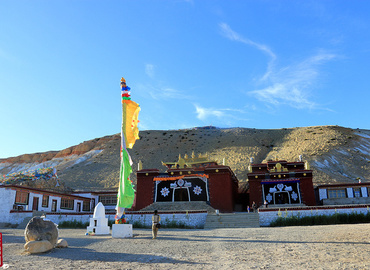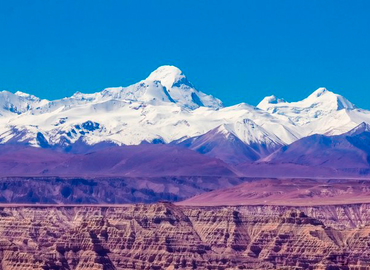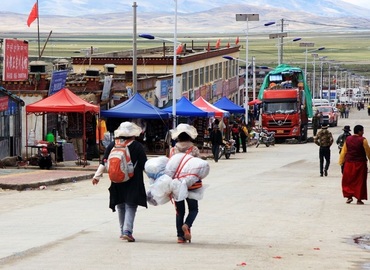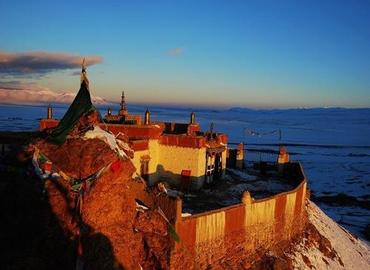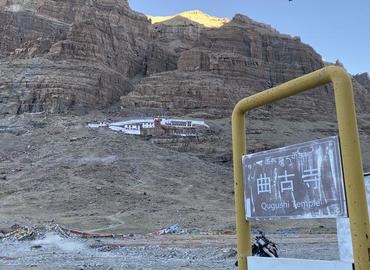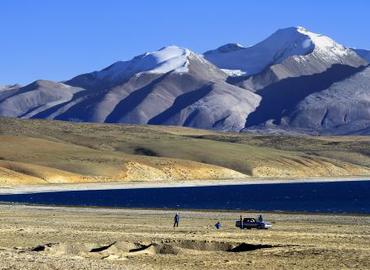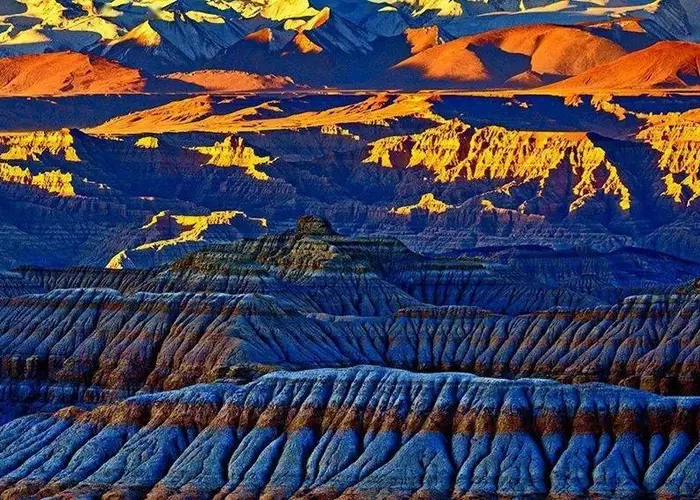Khyung Lung Dngul Mkhar was the capital of the ancient Zhangzhung Kingdom in Tibet. Its Tibetan name is Khyung Lung Dngul Mkhar(ཁྱུང་ལུང་དངུལ་མཁར།). “Khyung” means the Garuda, a mythical bird, and “Lung” means place, indicating the place where the Garuda lives. "Dngul" originally means silver, and here it refers to the silver color. "Mkhar" means fortress or palace. In short, Khyung Lung Dngul Mkhar means the Silver Palace of Garuda Valley.
The Sutlej River flows quietly in front of it for years. The capital of the Zhangzhung Kingdom has long been destroyed, but the ruins of the Khyung Lung Dngul Mkhar still hint at its former grandeur. In Zanda area of Nagri, it is considered more worth visiting than the ancient Guge Kingdom.
Overview
According to one of the earliest existing historical records of Tibet, the Old Tibetan Chronicle, after Semarkar married the Zhangzhung King Liknyashur, Songtsen Gampo once sent an envoy to visit her at the capital of the Zhangzhung Kingdom. In a song, Semarkar described the Khyung Lung Dngul Mkhar, saying: "My dowry place is the Khyung Lung Dngul Mkhar. People think it is vast, but from the outside, it looks like steep cliffs, and from the inside, it is gold and gems," and "from the outside, it looks pale and rugged."
Khyung Lung Dngul Mkhar was located at the upper gate of the Three Gates(upper, central, and lower gates) of the ancient Zhangzhung Kingdom, and it was the major castle of the 18 Zhangzhung kingdoms. The ruins sit on the unique Earth forest landscape, with white cliffs on both sides resembling the wings of the Garuda bird. The darker cliffs in the middle look like the body and head of the Garuda bird. The mountain is dotted with caves of various sizes, with niches and steps for storing scriptures.
The central palace of Khyung Lung Dngul Mkhar was built by King Tonpa Shenrab Miwoche of Zhangzhung for his son. It is recorded that the original central palace was surrounded by 18 smaller palaces, 360 temples, and 1,008 stupas from the inside out. The foundation was of gold, the walls of silver, the bolts of iron, the doors of conch shells, the corners of agate, and the battlements of copper. Now, after thousands of wind erosion and rain stripping, the ruins are integrated with the mountain. The varied caves look like layered palaces, making it easy to imagine the splendor of its prospect past.
In History
According to the earliest record about this palace, the founder of Yungdrung Bon, Tonpa Shenrab Miwoche, built the Khyung Lung Dngul Mkhar. The records indicate that Tonpa Shenrab Miwoche lived over 4,000 years ago. The first King of the ancient Zhangzhung Kingdom, Triwer Sergyi Jaruchan, at that time, was his patron. During this period, Zhangzhung was a powerful kingdom with a brilliant ancient civilization spanning Central Asia and the Tibetan Plateau.
Zhangzhung was divided into three regions: Inner Zhangzhung in the Nagri, Central Zhangzhung near Tangra Yumco of Nagqu, and Outer Zhangzhung centered on Mount Zelchol of Qamdo. The Khyung Lung Dngul Mkhar was the center of Inner Zhangzhung. It was an important cultural hub connecting Central Asia, South Asia, and Tibet, serving as the political, economic, and cultural center of the ancient Zhangzhung for thousands of years.
In 915 BC, the prince of Zhangzhung and Bon master Drenpa Namkha was born here, whose father was King Gyungyer Mukhö. Later, Master Drenpa Namkha attained enlightenment at Yungdrung Mountain, northwest of the Silver Palace of Garuda Valley.
In 644 AD, Songtsen Gampo attacked the Zhangzhung Kingdom because his sister Semarkar was snubbed by her husband. He captured the King of Zhangzhung, imprisoned him near the Tangra Yumco, and took over most of Zhangzhung's territory. Since then, the glorious Zhangzhung Kingdom gradually faded away, and the capital Khyung Lung Dngul Mkhar was buried by the sands of Ngari.
Were is Khyung Lung Dngul Mkhar?
After thousands of years, it’s now a challenge to identify the ruins of Khyung Lung Dngul Mkhar. Recent archaeological discoveries suggest two possible sites matching the descriptions of Khyung Lung Dngul Mkhar.
One site is the Qulong ruins in Zanda County of Ngari. The Qulong ruins sit on the cliffs southwest of Qulong Village. Local people call it the Silver Castle of Qulong. From across the river, the red, yellow, and silver soil layers shine in the sunlight, with the silver layer in the middle standing out, resembling a flying eagle. Besides, Qulong and Khyung Lung are transliterated similarly in the Tibetan language, both meaning eagle. The location and features match the ancient records of Khyung Lung Dngul Mkhar being a day's journey west of Mount Kailash. Many tourists consider this as the real ruins of the Khyung Lung Dngul Mkhar as its mountain topography looks like a roc, with silver color and castles.
The other possible site is on the top of Kardong Mountain in Gar County, which is considered a real ruin historically and religiously. The location of Kardong ruins is significant, at the confluence of the Sutlej, Quena, and Qugar rivers. In 2012, archaeological excavations revealed a cluster of ancient buildings, including stone houses, altars, and secret passages leading down the mountain, as well as artifacts such as stone grinding plates, iron armor pieces, arrowheads, and so on.
In particular, a stone statue was discovered, which is said to be that of Drenpa Namkha, the master of Bon religion. Drenpa Namkha is the most influential master in the development of our religion after Shenrab Miwoche. According to Bon's literature, he was a prince of the Zhangzhung Kingdom and was born in the palace of Khyung Lung Dngul Mkhar. His meditation cave is preserved on the cliffs near the Gurugem Monastery of Yungdrung Bon. In Bon religious literature, there are often records of going to Khyung Lung Dngul Mkhar to worship the statue of Drenpa Namkha. The discovery of the statue at Kardong Mountain provides one of evidence supporting this site as the real ruins.
Some scholars consider that Khyung Lung refers to the entire upper valley of the Sutlej River, and it’s a broad concept. The current Qulong Village is a narrow concept, referring to a village in the Khyung Lung Valley, which isn’t confirmed as the real ruins. So the exact location of the Khyung Lung Dngul Mkhar remains unresolved in the academic community.
How to Get to Khyung Lung Dngul Mkhar?
Khyung Lung Dngul Mkhar is located in Gar County of Ngari Prefecture, surrounded by large areas of earth forest, about 112 km away from Mount Kailash. Zanda County is located in the hinterland of Tibet, whether you are coming from Lhasa, Kathmandu or elsewhere, you need to travel a long way. There are two main ways to reach here: by road or by plane.
By Road
Driving from Lhasa to Ngari is a popular choice for most travelers. It's a fantastic road trip covering about 1300 kilometers, passing major Tibetan attractions like Yamdrok Lake, Karola Glacier, Tashilhunpo Monastery, Mount Everest, and Mount Kailash. After visiting Mount Kailash, you can go to Moincêr Township, pass by the Gurugem Monastery, and reach the Khyung Lung Dngul Mkhar. This route offers diverse landscapes and Tibetan culture and helps you acclimate to the altitude. What’s more, it’s also the most economical way.
By Plane
For travelers with tight schedules, you can fly to the Ngari. There are flights between Lhasa and Ngari, taking about 2 hours. From the Ngari Gunsa Airport, it's about a 2-hour drive to the ruins of Khyung Lung Dngul Mkhar.
Travel Tips
Khyung Lung Dngul Mkhar recognized by most tourists is located in Qulong Village. To visit the ruins of the ancient city, you need to wade across the river. There are not many tourists here.
- Khyung Lung Dngul Mkhar is currently free to visit. There are metal handrails for climbing, but the stone steps are steep, so be careful.
- Bring warm clothes. The temperature in the Ngari varies greatly between day and night.
- Be mindful of altitude sickness and take care of your skin. Ngari is a high-altitude region with an average elevation of 4,500 meters. The climate is dry, and UV radiation is strong.
- The food and accommodation along the way to the ruins of Khyung Lung Dngul Mkhar are relatively simple but expensive.
Conclusion
The ruins of the royal Khyung Lung Dngul Mkhar during the ancient Zhangzhung civilization are known as "the true roots of Tibetan civilization". The sand of the Ngari region no longer hides this glorious and prosperous civilization center 4,000 years ago. It is gradually showing us its ancient charm.
Lhasa - Gyantse - Shigatse - EBC - Saga - Lake Manasarovar - Darchen - Mt.Kailash Kora - Zada - Gegye - Gertse - Shigatse - Lhasa
Witness the magnificent landscape of western Tibet, experience 3-day kora and explore the lost civilizations of Ngari.
Email response within 0.5~24 hours.


